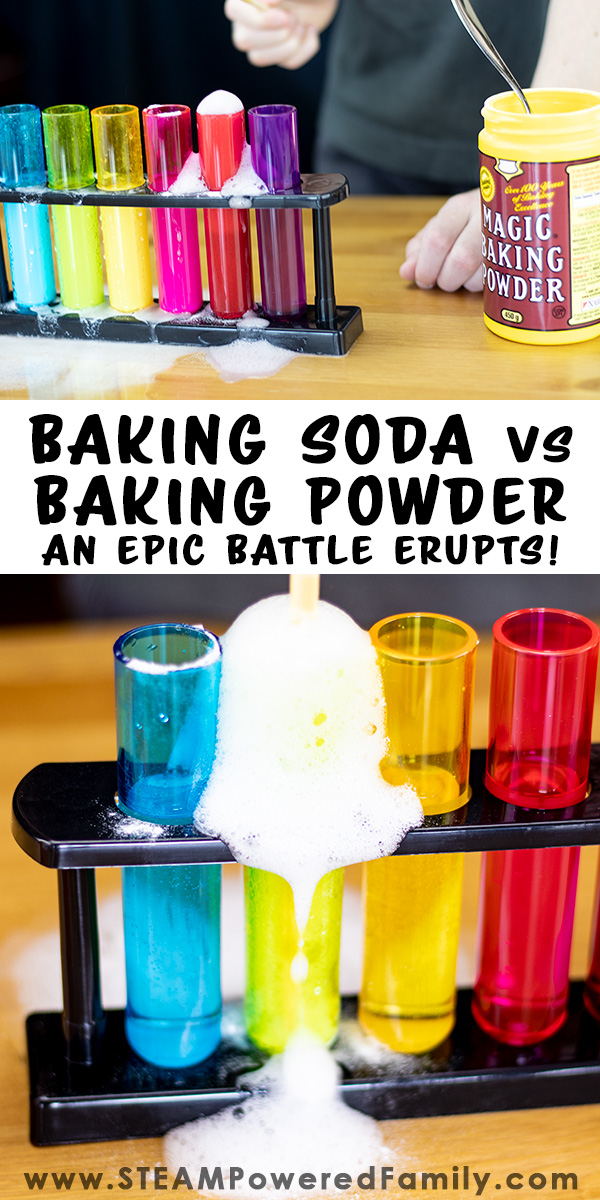Baking Soda vs Baking Powder Science Experiment
Baking Soda vs Baking Powder is an exciting head-to-head battle between two kitchen staples in this epic science experiment. They may look similar. Their names may sound similar. But these two simple looking white powders can cause some big reactions. The best part of this scientific investigation… creating kitchen science volcano eruptions!
BAKING SODA vs BAKING POWDER
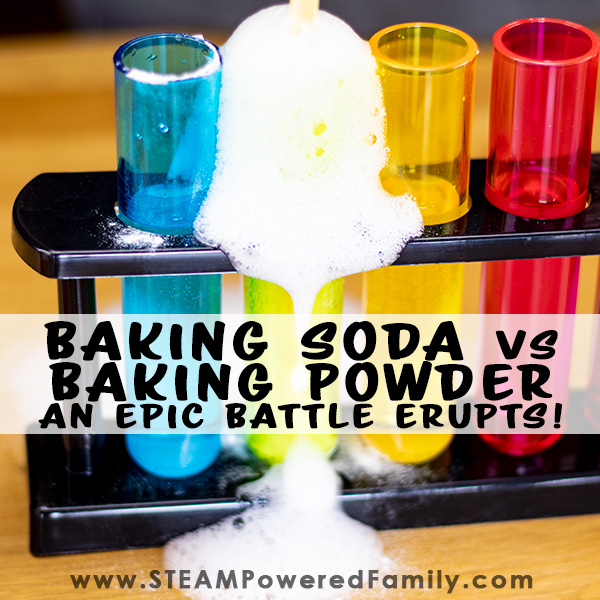
When we did our pH indicator experiment we had a big surprise with one of our tests. When we added baking powder to our pH indicator water it erupted. A lot!
We were expecting colour changes from our chemical reactions, not eruptions with tons of bubbles.
This surprise result ended up giving us a bunch of new questions that needed their own scientific investigation. Cue up the next scientific study and experiment into baking powder and baking soda!
Baking Powder Reaction In Water
We started by keeping things simple. Adding baking soda and baking powder to water.
We set up our test carefully. Adding the same amount of water to each glass.
Then we added a heaping tablespoon of baking soda to the first glass. Nothing happened.
So we added a heaping tablespoon of baking powder to the second glass. It fizzed, bubbled and erupted spectacularly!
But why did it erupt?
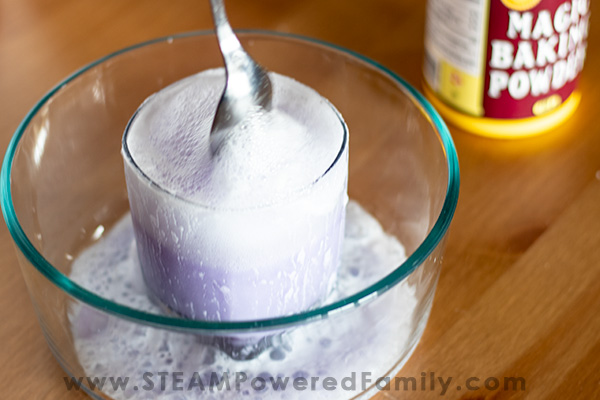
The Science Behind Baking Powder Eruptions
As we know from our pH indicator experiment baking soda is a base. It gave us a really nice reaction with our indicator in both our original experiment turning our indicator blue.
But it never erupted.
Baking powder on the other hand caused no change in the pH indicator colour, but it did cause a massive reaction, creating lots of bubbles and gas, resulting in a spectacular, long lasting, eruption.
Now we know from our previous studies that vinegar and baking soda react because they are an acid and a base. The result is CO2 gas that bubbles and releases which can give us some amazing reactions, like in our Bottle Rockets experiment or Hatching Dino Eggs.
But water isn’t an acid or a base, it has a neutral pH. So why the reaction?
First, we need to understand that Baking Soda has only one ingredient – sodium bicarbonate. It is a base. That’s it. There is nothing else in baking soda.
Baking Powder is completely different.
It turns out Baking Powder has components that are acids and components that are bases.
The base is baking soda and the acids are acid salts known as monocalcium phosphate and sodium aluminum sulfate.
When those acids and bases are combined with water they react creating gaseous carbon dioxide (CO2).
Interestingly, baking powder also has corn starch usually added as a stabilizing agent to help keep the acid and base components dry, preventing a premature reaction if stored in a humid environment. Cue the next experiment… pH Indicator Oobleck.
Baking Soda vs Baking Powder Science Experiment
To take the experiment a bit further we decided to test the reactions by upsetting the balance between the acids and bases in baking powder. We did this by using different liquid mediums.
First, we set out test tubes filled with water, vinegar, baking soda solution, rubbing alcohol, juice and liquid soap. We then repeated in a second set of test tubes.
Before starting the experiment we voiced our hypothesis for each test tube. Then it was time for some testing!
Pro Tip! This is a messy experiment. Prepare appropriately!
Want our colourful test tubes? These are amazing to use with young students because they are plastic and they are gorgeous colours. They are actually marketed as test tube shot glasses. You can grab them here:
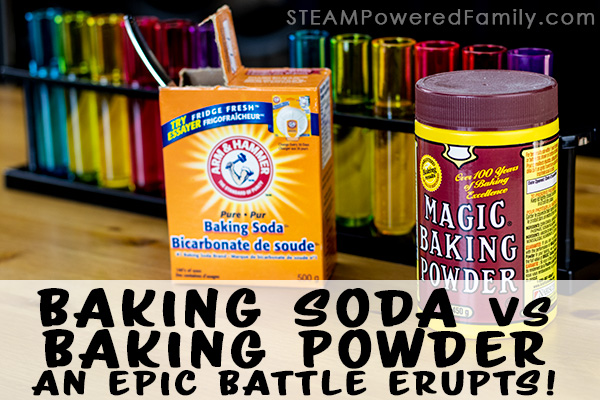
To the first set of test tubes we adding baking soda to each one and recorded the reactions. Not surprisingly the only tubes that reacted were vinegar and juice (our acids).
Then we added the baking powder to the second set of test tubes to see how those ones reacted.
The results were VERY exciting!
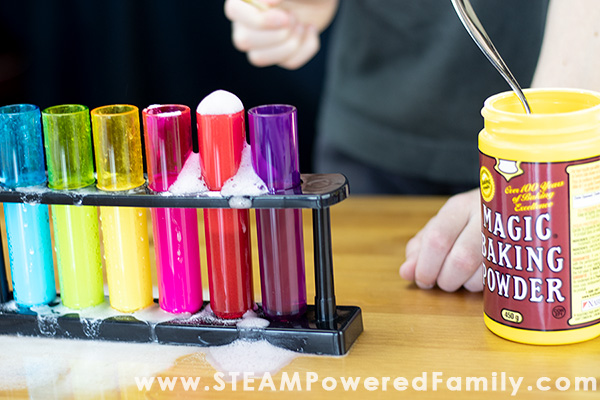
We had eruptions from 4 out of 6 tests! Water, vinegar, baking soda solution and juice all reacted. The best, and longest lasting reaction came from the juice!
A key finding we had was that baking powder gives a very long and sustained reaction. When we mix baking soda and vinegar we get a spectacular, instant and fast reaction. Baking powder gives a longer lasting reaction. It builds a little slower and lasts a LOT longer.
Check out our video. At the end we did a challenge with just Cranberry Juice and Baking Powder to see how long it would react. The results were shocking!!
Why Do We Want Baking Powder To Erupt?
So why would we want baking powder to erupt and take so long in the reaction? Doesn’t that seem a little crazy? I mean making our erupting Lava Toffee was fun (and delicious), but we don’t usually want our food to turn into mini volcanoes in the kitchen.
Well it turns out that reaction, and the release of CO2 gas is what makes our breads, cookies and cakes light and fluffy. We can thank English scientist Alfred Bird for this discovery in 1843 and all the resulting delicious, light and fluffy, tasty treats we now enjoy.
We want the long lasting reaction because we want to bake our mixtures while the reaction is ongoing to capture that gaseous CO2 as it makes our batters light and fluffy.
Need more science on the differences between baking powder and baking soda? Check out this resource.
Science is soooo cool! Especially when it comes to food.
Looking for more food science to explore with the kids? Check out our Candy Science studies focusing on the crystallization process of sugar in candy making. It’s fun, educational and delicious!
Or grab our book, STEAM Kids In The Kitchen, which is packed full of fun STEAM activities to do in the kitchen with your kids.
Grab your digital copy here or you can get the paperback on Amazon.
